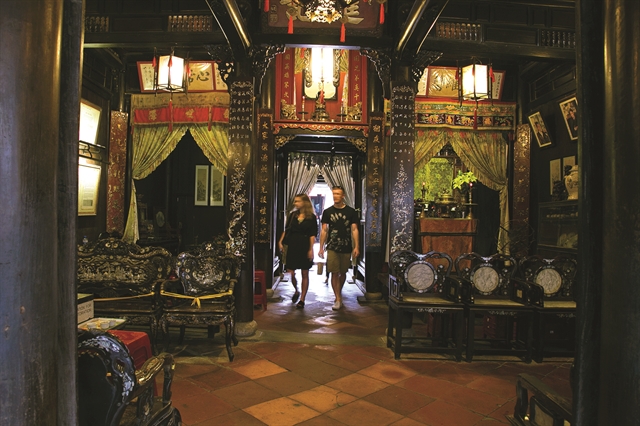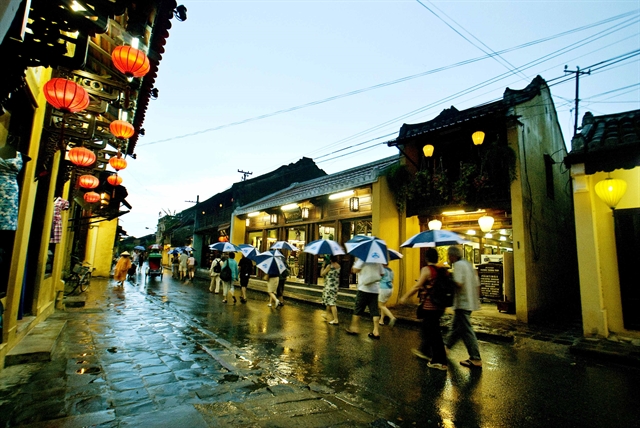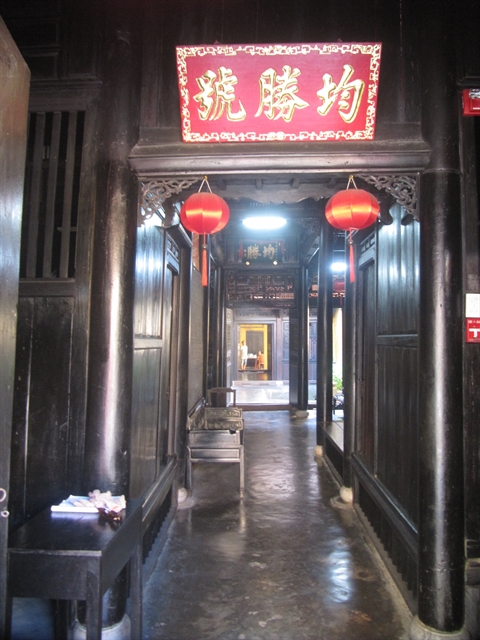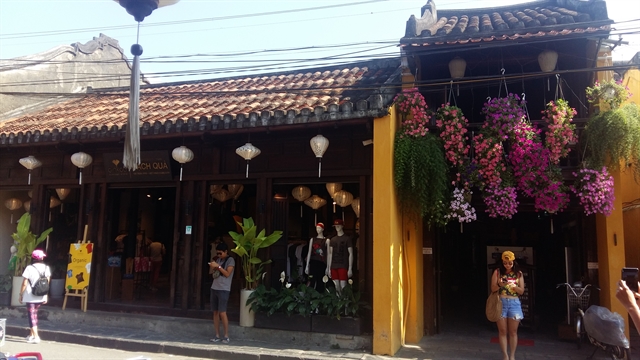 Sunday/Weekend
Sunday/Weekend

By Công Thành
.jpg) |
| VIEW OF THE BRIDGE: The Japanese Covered Bridge features an iconic symbol of Hội An ancient town from the previous centuries. VNS Photo Công Thành |
Built in the 18th century, the one-storey wooden structure Quân Thắng house in the Old Quarter of Hội An has sheltered eight generations of the family of Thái Quân Thắng – a tradesman from Fujian, China, who settled in Hội An – and has become a favourite destination since the Old Quarter was recognised as a UNESCO world heritage site in 1999.
The house is under the care of Diệp Ái Phương’s father – a member of the sixth generation of the Quân Thắng family in the country – as a living place for her parents and a visitor site.
Phương, 48, said that her father repaired the house in late 1960s, and he has been caring for the house ever since.
 |
| RESTORED INTERIOR: An old house in the Old Quarter of Hội An offers visitors an interesting history of architecture and culture of the ancient town from 400 years ago. Photo courtesy of the Hội An Centre for Cultural Heritage Management |
“My father was in Quy Nhơn City when his mother called him back to repair the house from ruin,” Phương said.
“My father was the only son of my grandmother, and he could fix the house redecoration. My parents lived in a house in Nguyễn Thái Học Street, just few blocks behind the house.”
She said the founder of the house, Quân Thắng, used it as a medicinal herb shop and living place for his family, so the house was designed with three parts with a strong timber columns structure.
It has two entrances connecting Nguyễn Thái Học and Trần Phú streets for easy access to merchant ships docking at the Hội An port, she said.
The house’s architecture and main furniture have been preserved for 150 years; only new paint and repairs of some wooden parts were needed due to the damage of time and annual flooding.
The latest restoration of the house was in 2016, with 60 per cent of the costs from a state fund, and the remaining from the family.
In the 14th century, two early business communities, the Chinese and Japanese, emerged in the business quarters around the vast port in the present streets of Bạch Đằng, Nguyễn Thị Minh Khai, Nguyễn Thái Học and Trần Phú.
 |
| ON TOUR: Tourists explore the Old Quarter of Hội An at night. The town is decorated by lanterns every night. Photo courtesy of the Centre for Cultural Heritage Management |
Iconic bridge
Another architectural symbol of Hội An was Chùa Cầu, or the Japanese Covered Bridge, sandwiched between Nguyễn Thị Minh Khai and Trần Phú streets.
The bridge features typical Japanese architecture, a cultural symbol of Hội An ancient town and favourite visit site over the past four centuries. It is a clear footprint of the Japanese business community in Hội An from previous centuries.
According to Hội An's Centre for Cultural Heritage Management, the bridge was built by the Japanese community in the 17th century as an omen against disasters and floods.
The arch bridge is seen as a sword weighing down on the back of a fictional monster that has its head in India with the body in Việt Nam and the tail in Japan. The monster was said to be able to create quakes and disasters, and the bridge was built in the hopes of a peaceful life for people in the three countries, according to archives from the Centre for Cultural Heritage Management.
The iconic symbol, which was named Lại Viễn Kiều (the bridge hosting universal visitors) by Lord Nguyễn Phúc Chu of the Nguyễn Dynasty in 1719, has remained a symbol against annual floods over past centuries with seven restorations completed, the latest in 1986. But experts had found cracks in the foundation and main structure, timber girders, beams and rafters due to the effects of time, erosion, and floods.
Vietnamese and Japanese experts and researchers started selecting restoration methods in 2016, but the project has taken six years to begin.
 |
| HERITAGE HOME: An entrance to Quân Thắng house in Trần Phú Street of Hội An. The house, which was built in the 18th century, and has been used as a living space for the eight-generation family of Thái Quân Thắng. It has become a tourist destination in Hội An. VNS Photo Công Thành |
“The bridge will be fully restored over 2022-23. It will be partially dismantled for preservation of the timber works, foundation, pillars and floors. Every single intervention must be based on science and history to ensure the long-term viability of the monument,” said Phạm Phú Ngọc, director of the Centre for Cultural Heritage Management.
“The restoration project on the bridge will be applied with the latest technology on the basic of preservation works -- that will not impair the cultural value of the bridge.”
Ngọc said baked clay double roof tiles, timber used for restoration of old architecture as well as manpower had been seen as big challenges for preservation of heritage relics in Hội An.
He said masons and carpenters must be skilful using artisanal techniques to work on roof tiling and rafter and girder replacing.
A complete restoration of the ancient relic had been given the go ahead, and the bridge will be partly dismantled for the restructuring of the foundation, joints and rafters on the upper structure, alongside termite treatment.
“We’ll restore the bridge with techniques that have been applied at many historical relic restoration projects, and they will help keep the origin of the bridge intact, allowing it to stand for longer,” Ngọc said.
Hiromichi Tomoda, professor from Showa Women’s University, said Japanese experts had cooperated with Hội An in the preservation of many relics in the ancient town over the years.
 |
| RICH HISTORY: Many old houses have remained intact in Trần Phú Street, which was part of a busy trading area of the port of Hội An ancient town from the 14th century. VNS Photo Công Thành |
He said Japanese merchants came to the town in the 16-17th century when a Japanese quarter was formed, and the bridge and Japanese tombs have been preserved under the care of local residents.
A survey from the Centre for Cultural Heritage Management said that Hội An ancient town has over 1,100 houses between 100 and 200 years old, of which 780 were recognised as heritage relics.
At least 114 houses were sold to new owners in 2000-2010, while 600 current owners of the old houses renovated and converted their houses into shops.
“Familiar with annual floods for generations, local people living in the Old Quarter have gradually strengthened their house structures when facing disasters. We’ll build up long term preservation by selecting adaptable materials,” Ngọc said. VNS




